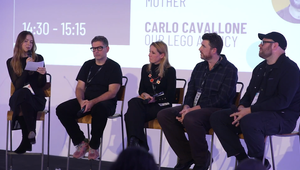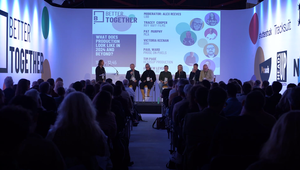
Where Ad Spend Is Going and What It Means for You: WARC and Advertising Association on UK Advertising Right Now

Last Wednesday, people from across the UK advertising industry came together for Little Black Book’s inaugural Better Together summit at Park Village in Camden. Opening up conversation across sectors to foster collective progress, six panels featured experts from brands like KFC, Cadbury and Guinness; production companies and agencies like Stink, Riff Raff and Heads Up Production; creative agencies like Mother and Uncommon; in-house agencies Sips & Bites and Our Lego Agency; and innovators like Shutterstock Studios and Whalar.
It’s an event that wasn’t to be missed; but in case you did, we’ve got you covered. We’re sharing all the key insights from every panel.
The introductory talk – ‘What Does the Market Look Like Right Now?’ – saw Alex Brownsell, head of content at WARC, and Sarah Virani, senior commercial manager at the Advertising Association, take stock of the industry as it currently stands, as well as predict where it’s headed. Here’s what we found out…
Global Ad Spend to Exceed $1 Trillion For the First Time Ever
To paint a picture of the market right now, Alex began with where brands are spending their money. According to last month’s advertising spend forecast from the world’s foremost experts on marketing effectiveness, WARC, global ad spend in 2024 will tip over the one trillion US dollar mark for the first time ever, up 10.5% year-on-year. Among the factors that could have caused the jump this year, Alex cited the US presidential election, the Paris Olympics, and the Euros.
Digital Channels Will Grow Fastest
Overall, the industry should continue this pattern of growth over the next two years, just not to the same extent as this year; “but not all boats benefit to the same extent,” reminded Alex. WARC data comparing projected year-on-year growth for 2024, 2025, and 2026 shows that digital channels will grow the fastest. Money is primarily being funnelled into retail media, connected TV, and social media, while legacy channels like publishing and radio show signs of shrinkage.
Alphabet, Amazon, and Meta Account for 44% of the Global Ad Market
Breaking advertising spend down by platforms, WARC’s research found that just three companies account for 44% of the global ad market and over half of all advertising spend outside of China: Alphabet, Amazon, and Meta.
Alex goes further, “The big thing about these three companies is, not only do they want you to spend your paid media there, but they increasingly want you to use their generative AI tools for things like creative asset development, for campaign management, for audience targeting, and everything in between. So it's not just necessarily media spend that those three companies are going after.”
Social Media to Receive $169.4 Billion More in 2025 Compared to 2019
Next, Alex compared next year’s projected global advertising investment with that of 2019, the year before the pandemic. Roughly, online news brands will have $1 billion extra, audio streaming will have $10 billion, connected TV will have $30 billion – and social media will have a whopping $169.4 billion.
It seems that brands are seeing social media as increasingly integral to their aims. Meta exemplifies the point: WARC predicts that next year, Meta will receive more in advertising revenue than the entire global linear TV market.
“There is one place within the social media ecosystem the money isn’t going – and that’s X,” noted Alex. WARC’s models suggest that since the point of Elon Musk’s takeover two years ago, it’s likely to be billions down from where it would have been otherwise considering Twitter’s historic relation with the social media app market.
It’s Been a Hard Year for TV – But the UK Is Resilient
WARC’s figures suggest this year was the hardest in terms of drop in year-on-year TV spot revenue going all the way back to 1983. But while markets like the US, Canada, China, Korea, Japan, France, and Germany are predicted to dip back down next year, the UK is actually set to grow again.
Alex suggested a couple of reasons. “In the UK, the TV market has done really well at convincing people that TV is a driver of long-term benefits for brands. What it's leaning into now is that performance side of things, looking at how TV can drive short term outcomes for brands, as well as building brands in the longer term.”
Secondly, “we're seeing the traditional TV broadcasters – the likes of ITV, Channel 4, Sky – are increasingly collaborating with the likes of Netflix, Amazon, Disney, potentially Apple as well.” Content is a significant driver in this: “the investment in content by the streamers has really helped to pick things up and solidify TV’s role in the market.”
The Ad Industry is Crucial for the UK’s Renewal
Sarah from the Advertising Association followed up by setting the UK’s ad industry within its political context.
The Labour government aims to have the highest sustained growth in the G7 by the end of its first term. Last month, it announced a strategy for achieving this, to which soft power creative industries, and the ad industry in particular, are critical; and at its first conference in power for 14 years, the importance of the UK’s soft power on the world stage was a consistent theme for ministers. As Sarah pointed out, “The government has stated that it needs the help of industry during the next decade of renewal to fix the many problems that the UK faces.”
1.4 Million UK Jobs Are Supported by Advertising and Marketing
Looking at the current shape of UK advertising, Sarah shared a number of findings from Credos, a think tank within the Advertising Association:
- Annual ad spend is reaching £40 billion, compared to £14.7 billion in 2000.
- 1.4 million UK jobs are supported by advertising and marketing.
- Advertising funds UK media to the tune of £15 billion and provides 28% of all TV revenues.
- 80% of ad spend goes into some kind of online format, compared to 1% in 2000, because of the vast growth of the UK’s digital economy.
- The UK has the second highest digital ad spend per capita in the world, second only to the US.
Public Trust in the UK Ad Industry’s Work Is Rising for the First Time in a Decade
Sarah identified three areas of focus for achieving the shared goal of national renewal. First up was trust from “our industry’s most important customer, the public.”
Critical to business success, the public’s trust in the UK ad industry’s work is rising for the first time in a decade. According to the Advertising Association’s ‘The Value of Trust Report’, the creative quality of the work is the most important driver of trust, as well as the social contribution work makes to solving customer problems.
“On the flip side,” said Sarah, “we need to reduce bombardment and address the challenge of high volume and low quality work.”
The Better the Representation, the Better the Work
The next area of focus Sarah carved out was inclusivity, underlining how the industry’s talent must reflect the nation. “The better our representation, the better our work will be in representing the wonderful and varied nature of UK society.”
Advertising Must Drive More Sustainable Behaviours
Last but not least, Sarah pointed to the importance of climate action, naming Ad Net Zero and AdGreen as two initiatives that are crucial for encouraging the industry and its clients to be more planet-friendly. “We have two goals: to decarbonize the industry and to use the power of advertising to drive more sustainable behaviours.”
All three areas of focus – trust, inclusion, and sustainability – must be tackled together, according to Sarah. “We can't do well in one of these without progress in the others. With true collaboration, we can produce better work that helps attract the best talent to deliver on real growth, not just for our industry, but wider UK society.”
A big thanks to our sponsors
Shutterstock | Park Village | Peach | NaF | Heads Up Production | Tracksuit
















